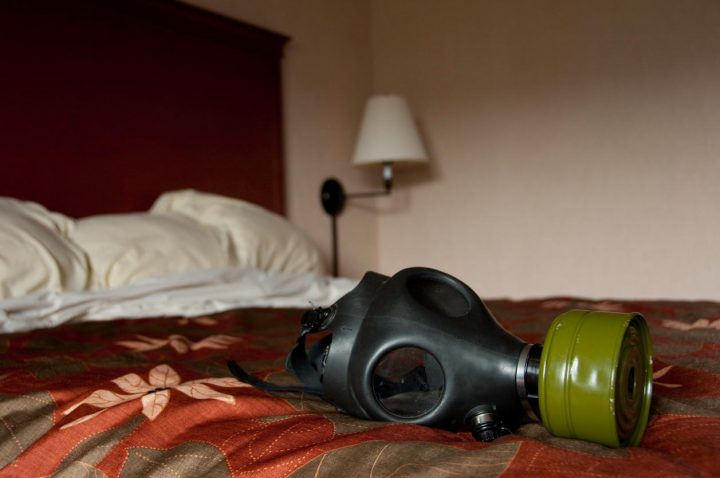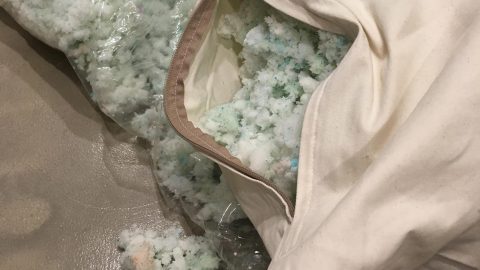
Some of the chemicals used in memory foam aren’t entirely benign.
Does Your Memory Foam Pillow or Mattress Have an Unpleasant Chemical Smell?
One of the biggest complaints by owners of memory foam pillows and mattresses is the unpleasant, and potentially unhealthy chemical smell. Memory foam is manufactured using polyurethane and several other chemicals, so it isn’t surprising that it emits a chemical odor. This “off gassing” of volatile organic compounds is a common and well-documented property of memory foam pillows and mattresses. The fumes are often compared to those experienced in a freshly painted room. If you are experiencing this odor, the good news is you may not have to endure the smell for long. The bad news is that some of the chemicals used in memory foam aren’t entirely benign.
Will the Odor Go Away?
Many memory foam mattress owners report that the off gassing period ends after a number of days. Of course there are many factors which influence this including the product, the type of foam, the sensitivity of the person, the room ventilation and more. Even if the initial odor goes away, it is natural to wonder if there are health issues related to off gassing.
Health Issues Related to Memory Foam Smell
Most people do not report any health issues resulting from their memory foam pillow or mattress. However, there are various reports of headaches, nausea, and allergic reactions resulting from the odor produced by memory foam. If you are experiencing any of these symptoms, you’ll want to avoid sleeping on the foam during the initial off gassing period. You can leave the pillow or mattress in a well-ventilated area for a week or two and see if that helps eliminate or reduce the odor and symptoms. If after several weeks, the issue persists, it is probably time to consider an alternative to memory foam.
Is Long-term Use of Memory Foam Healthy?
 Many many people use memory foam products without reporting any side effects or related health issues. That said, there are various reports and studies which indicate that memory foam may be somewhat toxic. Reports include carcinogenic chemicals and formaldehyde gas. To manufacture memory foam, chemicals are added to polyurethane to make it more dense and viscous at the same time. Additional chemicals are required to make the polyurethane flame retardant. One of these, Pentabde (of the polybrominated diphenyl ether (PBDE) family), was used until 2004. Pentabde is now known to be toxic to the liver, thyroid, and nervous system.(1) A study in 2000 specifically found mattress emissions to be toxic to the lungs of labratory mice.(2)
Many many people use memory foam products without reporting any side effects or related health issues. That said, there are various reports and studies which indicate that memory foam may be somewhat toxic. Reports include carcinogenic chemicals and formaldehyde gas. To manufacture memory foam, chemicals are added to polyurethane to make it more dense and viscous at the same time. Additional chemicals are required to make the polyurethane flame retardant. One of these, Pentabde (of the polybrominated diphenyl ether (PBDE) family), was used until 2004. Pentabde is now known to be toxic to the liver, thyroid, and nervous system.(1) A study in 2000 specifically found mattress emissions to be toxic to the lungs of labratory mice.(2)
The long-term effects of memory foam and its toxicity are not fully understood, but there clearly is some reason for concern. Aproximately one-third of your life is spent in close contact to your sleeping surface, so it is important to consider you and your family’s health when selecting a pillow or mattress.
Natural Alternatives to Memory Foam Pillows
Are you interested in the support and comfort provided by memory foam, but want to avoid that chemical smell? There are several natural pillow options for those looking for a new pillow. Of course, our favorite is our buckwheat hull pillow. Besides being natural and chemical-free, buckwheat pillows are a great alternative to memory foam for a couple of other reasons.
Memory foam is not breathable and this can result in a hot and sweaty pillow. The shape and particulate nature of buckwhat hulls leaves a lot of air space in your pillow between all of the hulls. This airspace allows warm moist air to escape, leaving your pillow cool and dry.
While a memory foam pillow conforms to the shape of your head, the overall shape and thickness of the pillow is fixed, making the pillow less adaptable to your sleeping position. The fill in a stuffed pillow can be shifted and adjusted for a wider variety of shapes and sizes.
If you’ve decided against a memory foam pillow and a buckwheat pillow isn’t right for you, other natural alternatives to memory foam include pillows filled with down, cotton, wool, latex, kapok or millet hulls.
- http://www.enn.com/pollution/article/33754
- http://www.ncbi.nlm.nih.gov/pubmed/10735518



